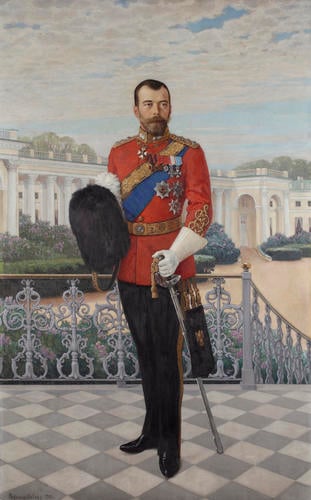Nicholas II (1868-1918), Emperor of Russia Signed and dated 1908
Oil on canvas | 232.5 x 146.8 cm (support, canvas/panel/stretcher external) | RCIN 406547
-
Painted by the Russian realist painter, Bogdanov-Belsky, this portrait of the Emperor was almost certainly presented to Edward VII after their meeting at Reval in June 1908, but before the imperial visit to Cowes in August 1909. It was already recorded by Lionel Cust in the Centre Room at Buckingham Palace in his published catalogue of 1909. Nicholas II is dressed in the uniform of the 2nd Dragoons (Royal Scots Greys), to which he had been appointed colonel-in-chief in 1894. Photographs taken at Balmoral in 1896 record the sitter in the full uniform of the regiment (and may have been provided as a reference for the artist (RCIN 2160254)). The Emperor wears the star and riband of the Garter and Royal Victorian Chain, the stars of the Orders of St Andrew and St Alexander Nevskii, and the badges of the Order of St Vladimir, the Danish Order of the Dannebrog and the Greek Order of the Redeemer.
By setting the portrait against the backdrop of the elegant northern façade and double colonnade of the Alexander Palace, the artist has created an entirely fictitious scene by amalgamating a terrace with its ornate iron balcony from the east wing of the palace building c.1896, by Silvio Dagnini (1867–1942), added as part of the remodelling of the palace in preparation for the residence of Nicholas II and his family. Access to the balcony was from the Empress’s suite of rooms, it then wrapped round to the south side of the building, with steps down towards the Emperor’s study. However, the structure adds a wonderful decorative quality to the painting and appears in numerous contemporary photographs.
Born into a peasant family in the Smolensk region, Bogdanov-Belsky trained under Ilya Repin (1844–1930), Russia’s foremost realist painter, and later in Paris. In addition to portraits, he favoured genre and rural peasant scenes; this portrait exemplifies certain aspects of his style, notably the use of heightened colour and richly impastoed pigment. Passages of paint, for example the rendering of the lilac growing beyond the curlicues of the balcony, suggest an affinity with the symbolist painter, Victor Boris-Mustov (1870–1905). Indeed the presence of lilac in the painting may be an oblique reference to the Empress, whose favourite plant and hue this was. Recent conservation has revealed the vibrancy of the original portrait, and also that the artist has used two different white pigments (lead white and zinc white) and has reworked certain areas, noticeably the sky, a number of times.
Nicholas II (1868-1918) succeeded his father Tsar Alexander III, in 1894, to become the last Tsar of Russia. In the same year he married Princess Alexandra of Hesse-Darmstadt, with whom he had four daughters- Olga, Maria, Tatiana, and Anastasia, and a son, Alexis. Nicholas was deposed during the Russian Revolution and he and his family were murdered by the Bolsheviks in 1918. He was related to Queen Victoria by marriage; as the Prince of Wales, her son Edward had married Alexandra, daughter of the King of Denmark; Alexandra's sister Maria married Tsar Alexander III, and Nicholas was their child.
Bogdanov-Belsky (1868-1945) studied at the Moscow School of Art, and icon-painting at the Troitse-Sergiyeva Lavra in 1883. After 1921, he worked exclusively in Riga, Latvia. He was a member of several important societies, such as the Arkhip Kuindzhi Society, of which he was chairman from 1913 to 1918.
Text adapted from Russia: Art, Royalty & the Romanovs, London, 2018Provenance
Presented by the sitter to King Edward VII, 1908; first recorded in the Centre Room, Buckingham Palace
-
Creator(s)
(artists' materials maker)(nationality)(nationality)Acquirer(s)
-
Medium and techniques
Oil on canvas
Measurements
232.5 x 146.8 cm (support, canvas/panel/stretcher external)
268.3 x 177.0 x 11.5 cm (frame, external)
Category
Object type(s)









